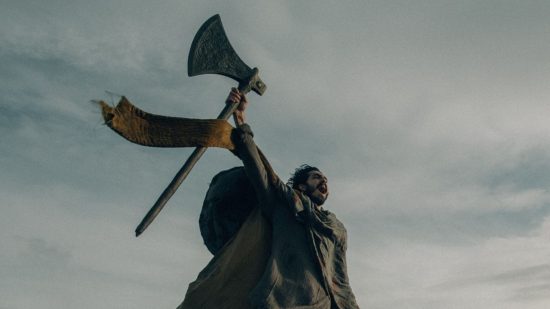Review: The Green Knight – “Haunting and playful, magical and dusty, dream-like and arresting”
The Green Knight, directed by David Lowery is a retelling of the 14th Century Arthurian poem, Sir Gawain And The Green Knight. It begins on Christmas morning as Gawain (Dev Patel), not yet a Sir is woken by a jug of beer thrown over him by his lover Essel (Alicia Vikander). As he stumbles from room to room in the brothel, Gawain dresses and makes his way home to prepare to sit at court. While at court he is beckoned by the King (Sean Harris) to sit at his side. The King asks Gawain to regale a tale, so that he may come to know his nephew. Gawain replies that he has none to tell. Yet. He has none to tell yet, states the Queen (Kate Dickie). Then the Green Knight, resembling a hybrid of an Ent and Ring Wraith from Peter Jackson’s The Lord Of The Rings enters the court. The Green Knight challenges anyone present to land a blow on him, only for them to return one year from now to The Green Chapel to receive an equal blow. With the room silent, Gawain steps forward, being handed The King’s sword. The Green Knight takes a knee and offers his neck. Gawain cuts the challenger’s head off, only for the beheaded Knight to stand, pick his head up and ride away laughing.
So begins Lowery’s sumptuous tale that takes Gawain on a journey of self-discovery, danger and temptation. The film has a meditative quality to it, but still remains adventurous. It’s a fever dream quest with a pleasantly ambiguous narrative and morality. There were hints of Lowery’s capabilities to produce a work of such quality with his beautiful tale of loss, bereavement and yearning with 2017’s A Ghost Story. But The Green Knight is by far his finest film to date.
The cinematography by Andrew Droz Palermo is breathtaking. He paints pictures that are thick with smoke like Bergman’s The Seventh Seal. The camera moves slowly, with assurance and inevitability with some striking set-pieces. The highlight of which is a sequence where Dev Patel’s Gawain has been robbed and tied up. Unable to move the passage of time claims him and the camera pans 360 degrees and then back again as Gawain refuses to accept this as his fate. Kubrick can also be felt as an influence as the camera moves across the bloodied and muddy aftermath of a corpse-strewn battlefield, reminiscent of Kubrick’s own Paths Of Glory. And for all the technical brilliance of the cinematography, it never once dominates and removes you from the action. It only acts to draw you in further.
The soundtrack is filled with era-appropriate sounding woodwind and string instruments that haunt and arrest in equal measure, complimenting Daniel Hart’s wonderful compositions.
Dev Patel’s central role as Gawain strikes every note perfectly. He breathes life into a flawed legend. He is rash and thoughtful, tender and cold, brave and cowardly, principled and self-serving. He is real and grounded, which is quite a feat considering the dream-like feel of the film that has headless Knights, lamenting giants and yearning spirits. This must surely rank as one of his finest performances to date in a career littered with fine performances.
Alicia Vikander is superb as both the loving brothel worker, Essel and as the duplicitous The Lady. Her speech on nature’s reclamation of the world and man returning to the green moss is as powerful and scene-stealing as Willem Defoe’s speech in The Lighthouse.
The supporting cast is faultless with Barry Keoghan as the sinister battlefield scavenger, Joel Edgerton as the tantalizing The Lord and the up-and-coming Erin Kellyman who was last seen in Marvel’s The Falcon And The Winter Soldier is haunting as Winifred. The Witch’s Ralph Ineson continues to go from strength to strength as the titular Green Knight, who is both terrifying and playful.
The Green Knight is haunting and playful, magical and dusty, dream-like and arresting. It contradicts and continually questions itself. Its canvases are sumptuous and rich. It immerses you in its magical fever dream world and will haunt you for days to come afterward.










